Art of the Genre: The Top 10 Role-Playing Games of All-Time
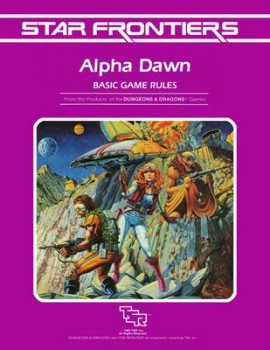 In my continuing series of ‘Top 10s’, I’m very happy to be doing a subject that incorporates two things I would simply have a hard time living without: fantasy gaming art and the games themselves. So, considering I’m currently in the middle of running a Kickstarter that not only is looking to produce an absolute load of original fantasy fiction, but also an RPG and art book, what better time to compose a list of The Top Ten Role-Playing Games of All Time.
In my continuing series of ‘Top 10s’, I’m very happy to be doing a subject that incorporates two things I would simply have a hard time living without: fantasy gaming art and the games themselves. So, considering I’m currently in the middle of running a Kickstarter that not only is looking to produce an absolute load of original fantasy fiction, but also an RPG and art book, what better time to compose a list of The Top Ten Role-Playing Games of All Time.
Now, I suppose I should mention that I’ve been playing RPGs since I was 10, and without revealing just how old I am, it must be understood there is a measurable amount of time involved there. Certainly, I’m not the foremost expert on role-playing games, but I’m going to put myself in the upper 10% of gamers and that should give me enough perspective to comprise this list.
Having established that I can’t help but say that going back in time, weighing the impact, reach, and longevity of so many games was an absolute thrill, and so many memories came flooding back with each one. I was also surprised at how many I’d played (all of them), even if just once during a random gaming session in some long forgotten era of my life.
These games, you see, are like time capsules of memory, and when they come up in conversation with gamers, I think every one of those in the discussion is ripped back through time to the point where they sat at a table, rolled dice, and laughed with friends most likely long out of their lives. Only games that take place on a table-top make such an intimate miracle happen, their power unmistakable and their reach deeper than most non-gamers would ever understand.
So, without further ado, let’s get into the meat of this list and find out just what games made it in, which ones were snubbed, and how many people can disagree with my choices!
Let me say right off, this was a very difficult list to make, and as you can see below, I just couldn’t bump some games completely and had to add a couple of honorable mentions, so that’s where we start.
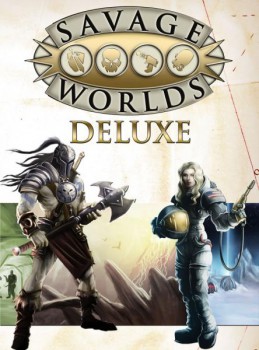 Honorable Mention #1 Savage Worlds (Pinnacle Entertainment Group, 1st Edition 2003) I got to meet Savage Worlds creator Shane Hensley at GenCon in 2012 and when I asked him how he came up with the Savage Worlds mechanic, he told me point blank that it was because he was a lazy gamemaster. To me, that was the finest response he could have ever delivered, and indeed, Savage Worlds is both the gamemaster’s best friend and yet still an incredibly rich and progressive place for players to spend their time. Taking a page from Steve Jackson’s GURPS, Savage Worlds is a generic gaming system that can be modified with ease to any setting one can imagine using the rather trim 158 page core rulebook. I truly can’t say enough about this system that hasn’t already been said with its various awards, but dang, in the end you get to use playing cards and poker chips as you game, and that just takes it over the top!
Honorable Mention #1 Savage Worlds (Pinnacle Entertainment Group, 1st Edition 2003) I got to meet Savage Worlds creator Shane Hensley at GenCon in 2012 and when I asked him how he came up with the Savage Worlds mechanic, he told me point blank that it was because he was a lazy gamemaster. To me, that was the finest response he could have ever delivered, and indeed, Savage Worlds is both the gamemaster’s best friend and yet still an incredibly rich and progressive place for players to spend their time. Taking a page from Steve Jackson’s GURPS, Savage Worlds is a generic gaming system that can be modified with ease to any setting one can imagine using the rather trim 158 page core rulebook. I truly can’t say enough about this system that hasn’t already been said with its various awards, but dang, in the end you get to use playing cards and poker chips as you game, and that just takes it over the top!
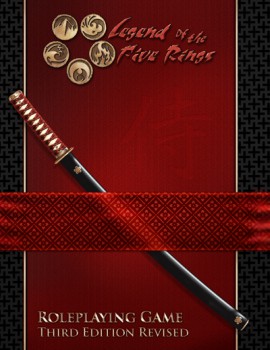 Honorable Mention #2: Legend of the Five Rings (Aldrec Entertainment Group, 1st Edition 1995) Created by John Wick, this game set in the backdrop of a hybrid of Feudal Japan and the continental Far East was the first, and only, RPG to ever have the power of sustaining Western interest in an Eastern setting. Where games like Bushido and Oriental Adventures failed to hold market share, L5R stayed the course and not only taught us what honor truly means, but also gave everyone the ability to live out a samurai fantasy that sat unattended in their imaginations. Certainly helped along by its popular collectible card game of the same name, L5R nonetheless has produced some absolutely fantastic role-playing books in the half a dozen editions since its inception.
Honorable Mention #2: Legend of the Five Rings (Aldrec Entertainment Group, 1st Edition 1995) Created by John Wick, this game set in the backdrop of a hybrid of Feudal Japan and the continental Far East was the first, and only, RPG to ever have the power of sustaining Western interest in an Eastern setting. Where games like Bushido and Oriental Adventures failed to hold market share, L5R stayed the course and not only taught us what honor truly means, but also gave everyone the ability to live out a samurai fantasy that sat unattended in their imaginations. Certainly helped along by its popular collectible card game of the same name, L5R nonetheless has produced some absolutely fantastic role-playing books in the half a dozen editions since its inception.
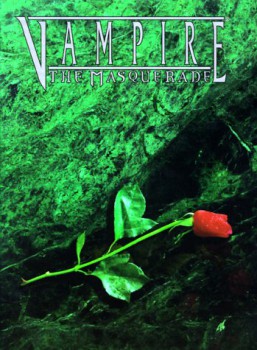 NUMBER TEN: Vampire the Masquerade (White Wolf, 1st Edition 1991) Although I don’t like vampires, be they shiny or horrific, this game has to be given its props as it propelled White Wolf into a full-fledged gaming company when gaming companies were in the process of dying in droves. This game has seen three editions in its two decades, as well as a 20th anniversary edition back in 2011. It also spawned a large line of games based around its core like Werewolf: The Apocalypse, Mage: The Ascension, Wraith: The Oblivion, Changeling: The Dreaming, Hunter: The Reckoning, Mummy: The Resurrection, Kindred of the East and Demon: The Fallen. That alone should put it higher on the list, but like I said, I don’t like vampires, so Masquerade should be happy it made it at all!
NUMBER TEN: Vampire the Masquerade (White Wolf, 1st Edition 1991) Although I don’t like vampires, be they shiny or horrific, this game has to be given its props as it propelled White Wolf into a full-fledged gaming company when gaming companies were in the process of dying in droves. This game has seen three editions in its two decades, as well as a 20th anniversary edition back in 2011. It also spawned a large line of games based around its core like Werewolf: The Apocalypse, Mage: The Ascension, Wraith: The Oblivion, Changeling: The Dreaming, Hunter: The Reckoning, Mummy: The Resurrection, Kindred of the East and Demon: The Fallen. That alone should put it higher on the list, but like I said, I don’t like vampires, so Masquerade should be happy it made it at all!
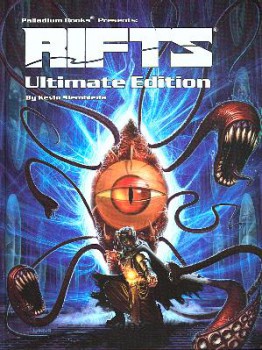 NUMBER NINE: Rifts [Palladium, 1st (and only!) Edition 1990] This multi-genre RPG is based on the antiquated Palladium system, but still, there is something to be said for a game that is still in print and has never, ever, gone through a revision. I mean, it’s been 23 years! In that time period, D&D has had four editions (if you include the yet to be released ‘Next’) all by itself. But back to the topic. Rifts is a very cool design in that it brings everything a gamer could ever want into a post-apocalyptic conflagration through a series of dimensional rifts that also provide any gamemaster with an infinite number of possibilities from week to week. Think about how many gaming groups have fallen apart, how many campaigns have turned to dust, all because people got tired of the same old story. Rifts changes all that, because one week your characters could be fighting aliens in giant mecha and the next they could be raiding a dragon’s hoard with Vikings. Not bad, Mr. Siembieda, not bad at all…
NUMBER NINE: Rifts [Palladium, 1st (and only!) Edition 1990] This multi-genre RPG is based on the antiquated Palladium system, but still, there is something to be said for a game that is still in print and has never, ever, gone through a revision. I mean, it’s been 23 years! In that time period, D&D has had four editions (if you include the yet to be released ‘Next’) all by itself. But back to the topic. Rifts is a very cool design in that it brings everything a gamer could ever want into a post-apocalyptic conflagration through a series of dimensional rifts that also provide any gamemaster with an infinite number of possibilities from week to week. Think about how many gaming groups have fallen apart, how many campaigns have turned to dust, all because people got tired of the same old story. Rifts changes all that, because one week your characters could be fighting aliens in giant mecha and the next they could be raiding a dragon’s hoard with Vikings. Not bad, Mr. Siembieda, not bad at all…
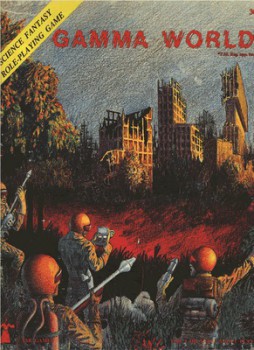 NUMBER EIGHT: Gamma World (TSR, 1st Edition 1978) Created by James M. Ward and Gary Jaquet as the first post-apocalyptic science fiction RPG, this game has captured the imaginations of doomsayers everywhere since before the Cold War ended. There seems to be an innate fascination with the end of the world, be it from a global thermal nuclear war, zombie outbreak, alien invasion, or super-bug and Gamma World finds a way to bring the fantastic to this type of setting. It has survived seven editions and three companies, but still, Gamma World remains a fun and functional game in the current RPG marketplace.
NUMBER EIGHT: Gamma World (TSR, 1st Edition 1978) Created by James M. Ward and Gary Jaquet as the first post-apocalyptic science fiction RPG, this game has captured the imaginations of doomsayers everywhere since before the Cold War ended. There seems to be an innate fascination with the end of the world, be it from a global thermal nuclear war, zombie outbreak, alien invasion, or super-bug and Gamma World finds a way to bring the fantastic to this type of setting. It has survived seven editions and three companies, but still, Gamma World remains a fun and functional game in the current RPG marketplace.
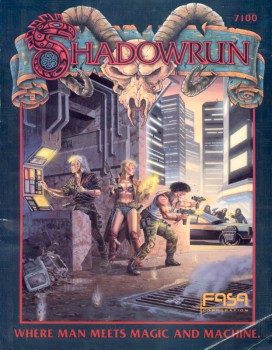 NUMBER SEVEN: Shadowrun (FASA, 1st Edition 1989) With the advent of Gibson’s Neuromancer and Scott’s rendition of Dick’s Bladerunner, every gamer must have known Cyberpunk was on its way to the gaming table by the late 1980s. Although there were many attempts to fill this niche, FASA’s Shadowrun was by far the most successful. It also ranks up there with pure gaming genre bending as it incorporates the Rebel Southern States of the former U.S. with Native American tribes; go-ganger bikers; and full-on fantasy races from orcs, elves, and dwarves, all the way to dragons. It also runs the world through corporations that must be taken down by runners, players who keep to the shadows, and stay out of the way of Mr. Johnson, another word for ‘the man’. Through five editions of the game, it still finds a way to showcase what gamers have enjoyed about it even today. Because of this game many players can still tell you what a decker, a street samurai, and smartlinks are without batting an eye.
NUMBER SEVEN: Shadowrun (FASA, 1st Edition 1989) With the advent of Gibson’s Neuromancer and Scott’s rendition of Dick’s Bladerunner, every gamer must have known Cyberpunk was on its way to the gaming table by the late 1980s. Although there were many attempts to fill this niche, FASA’s Shadowrun was by far the most successful. It also ranks up there with pure gaming genre bending as it incorporates the Rebel Southern States of the former U.S. with Native American tribes; go-ganger bikers; and full-on fantasy races from orcs, elves, and dwarves, all the way to dragons. It also runs the world through corporations that must be taken down by runners, players who keep to the shadows, and stay out of the way of Mr. Johnson, another word for ‘the man’. Through five editions of the game, it still finds a way to showcase what gamers have enjoyed about it even today. Because of this game many players can still tell you what a decker, a street samurai, and smartlinks are without batting an eye.
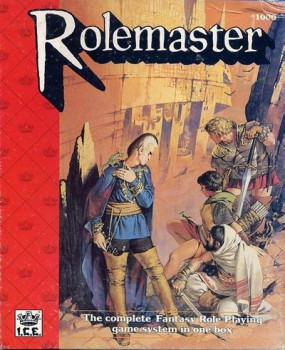 NUMBER SIX: Rolemaster (I.C.E. 1st Edition 1980) Produced for the first time in 1980, this base rules set, made famous for its ‘Law’ series (Spell Law, Arms Law, etc.) redefined what it meant to be a fantasy gamer even as Advanced Dungeons & Dragons was taking over the world. Also attributed to the frame of the Middle-Earth Role-Playing Game, which was the 2nd most popular fantasy RPG of the 1980s, I.C.E.’s Rolemaster must certainly make a showing as something of a heavyweight in the industry, even if it no longer exists as an entity, although the 2012 announcement of Rolemaster Unified does give some hope that it will rise from the ashes once more to bring action to gaming tables across the county.
NUMBER SIX: Rolemaster (I.C.E. 1st Edition 1980) Produced for the first time in 1980, this base rules set, made famous for its ‘Law’ series (Spell Law, Arms Law, etc.) redefined what it meant to be a fantasy gamer even as Advanced Dungeons & Dragons was taking over the world. Also attributed to the frame of the Middle-Earth Role-Playing Game, which was the 2nd most popular fantasy RPG of the 1980s, I.C.E.’s Rolemaster must certainly make a showing as something of a heavyweight in the industry, even if it no longer exists as an entity, although the 2012 announcement of Rolemaster Unified does give some hope that it will rise from the ashes once more to bring action to gaming tables across the county.
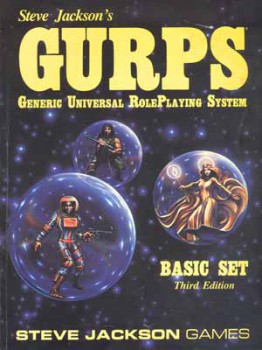 NUMBER FIVE: GURPS (Steve Jackson Games, 1st Edition 1986) What can be said about Steve Jackson other than he’s probably upset he didn’t get number one on this list. I mean, the guy named his company after himself, and I’m sure he’d have like to call GURPS, which stands for Generic Universal Role-Playing System, SJRPs, but it just doesn’t roll off the tongue as well. Still, GURPS is a very cool idea, especially considering it was created during a time of very hard adherence to finding a genre to fill and making a game that holds fast within it. The ability of GURPS to allow players to play in any setting with the same set of core rules captured the minds and wallets of many gaming fans during the late 1980s and is still popular today.
NUMBER FIVE: GURPS (Steve Jackson Games, 1st Edition 1986) What can be said about Steve Jackson other than he’s probably upset he didn’t get number one on this list. I mean, the guy named his company after himself, and I’m sure he’d have like to call GURPS, which stands for Generic Universal Role-Playing System, SJRPs, but it just doesn’t roll off the tongue as well. Still, GURPS is a very cool idea, especially considering it was created during a time of very hard adherence to finding a genre to fill and making a game that holds fast within it. The ability of GURPS to allow players to play in any setting with the same set of core rules captured the minds and wallets of many gaming fans during the late 1980s and is still popular today.
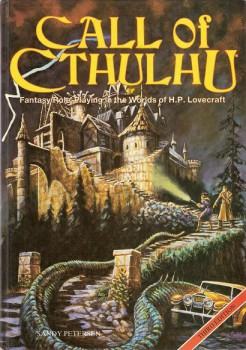 NUMBER FOUR: Call of Cthulhu (Chaosium, 1st Edition 1981) Certainly the most acclaimed horror-based, or should I say insanity-based, RPG of all time, Call of Cthulhu is a gamer’s paradise. First released in 1981 by Chaosium, this now venerable game still finds its way onto bookshelves of gamers for all those who love a good mystery, to be sacred to death while sitting at a gaming table, and to lose characters by the dozen. With various revisions, but never a full rewrite of its percentile-based system, Call of Cthulhu might be antiquated by today’s standards, but remember it is supposed to be set in the 1920s, so to me that seems more than appropriate.
NUMBER FOUR: Call of Cthulhu (Chaosium, 1st Edition 1981) Certainly the most acclaimed horror-based, or should I say insanity-based, RPG of all time, Call of Cthulhu is a gamer’s paradise. First released in 1981 by Chaosium, this now venerable game still finds its way onto bookshelves of gamers for all those who love a good mystery, to be sacred to death while sitting at a gaming table, and to lose characters by the dozen. With various revisions, but never a full rewrite of its percentile-based system, Call of Cthulhu might be antiquated by today’s standards, but remember it is supposed to be set in the 1920s, so to me that seems more than appropriate.
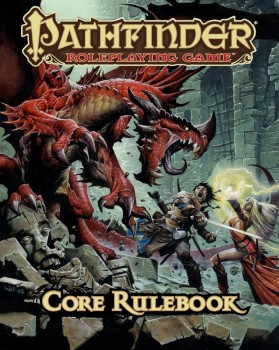 NUMBER THREE: Pathfinder (Piazo, 1st Edition 2008) Paizo proves that sometimes the best thing that can happen to you is that you get fired. In 2007, Wizards of the Coast didn’t renew Paizo’s license for producing both Dragon and Dungeon magazines and the company was faced with a hard choice, either die or adapt. They chose to maintain the momentum they’d built with something called an ‘adventure path’ in their magazines and translate that to WotC’s open game license on D&D 3.5. The release of the Pathfinder RPG in 2008 was the springboard needed by the company to harness the power of a glut of D&D 3.0 and 3.5 players incensed by WotC’s change to D&D 4E. The result is a game that has revolutionized what it means to use an OGL to your favor while making a name for itself as an inspired company who has the best wishes of their players foremost in their minds.
NUMBER THREE: Pathfinder (Piazo, 1st Edition 2008) Paizo proves that sometimes the best thing that can happen to you is that you get fired. In 2007, Wizards of the Coast didn’t renew Paizo’s license for producing both Dragon and Dungeon magazines and the company was faced with a hard choice, either die or adapt. They chose to maintain the momentum they’d built with something called an ‘adventure path’ in their magazines and translate that to WotC’s open game license on D&D 3.5. The release of the Pathfinder RPG in 2008 was the springboard needed by the company to harness the power of a glut of D&D 3.0 and 3.5 players incensed by WotC’s change to D&D 4E. The result is a game that has revolutionized what it means to use an OGL to your favor while making a name for itself as an inspired company who has the best wishes of their players foremost in their minds.
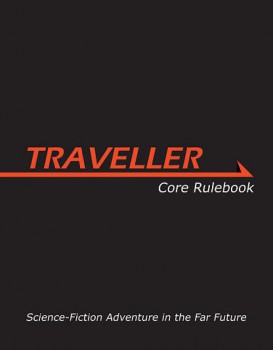 NUMBER TWO: Traveller (Game Designer’s Workshop, 1st Edition, 1977) Developed by Mark Miller and drawing from some of the greatest science fiction writers of the 1970s like Asimov, Piper, Niven, Pournelle, and Anderson, this was the first science fiction RPG to hit the shelves of gaming stores just as D&D was truly taking flight. Packaged in a plain black jacket with some simple bars of color, there is nothing inherently fancy about Traveller, and yet it has remained a viable source of entertainment to gamers through ten editions and six gaming companies that have controlled its license. Personally, I’ve always been partial to TSR’s Star Frontiers, but that game probably wouldn’t have existed without the fame and success that Traveller brought to the science fiction RPG genre.
NUMBER TWO: Traveller (Game Designer’s Workshop, 1st Edition, 1977) Developed by Mark Miller and drawing from some of the greatest science fiction writers of the 1970s like Asimov, Piper, Niven, Pournelle, and Anderson, this was the first science fiction RPG to hit the shelves of gaming stores just as D&D was truly taking flight. Packaged in a plain black jacket with some simple bars of color, there is nothing inherently fancy about Traveller, and yet it has remained a viable source of entertainment to gamers through ten editions and six gaming companies that have controlled its license. Personally, I’ve always been partial to TSR’s Star Frontiers, but that game probably wouldn’t have existed without the fame and success that Traveller brought to the science fiction RPG genre.
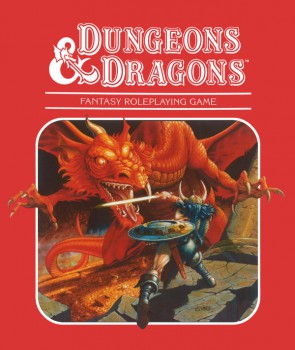 NUMBER ONE: Dungeons & Dragons (TSR, 1st Edition 1974) Do I really need to go into this choice? OK, if you insist. Gary Gygax and Dave Arneson created classic D&D as what is arguably the first role-playing game in world history back in the mid-1970s and the gaming universe has never been the same. It can also be argued that when table-top gaming was all but dead, D&D once again revived the industry with the advent of D&D 3E and the open game license that started the gaming boom of the early 2000s, as well as the foundation of Paizo’s Pathfinder RPG which also appears on this list. The grand-daddy of all games, D&D just keeps on going, and although there might always be ‘edition wars’ between players, that just says that it effectively stays within the consciousness of multiple generations of players as a relevant piece of entertainment.
NUMBER ONE: Dungeons & Dragons (TSR, 1st Edition 1974) Do I really need to go into this choice? OK, if you insist. Gary Gygax and Dave Arneson created classic D&D as what is arguably the first role-playing game in world history back in the mid-1970s and the gaming universe has never been the same. It can also be argued that when table-top gaming was all but dead, D&D once again revived the industry with the advent of D&D 3E and the open game license that started the gaming boom of the early 2000s, as well as the foundation of Paizo’s Pathfinder RPG which also appears on this list. The grand-daddy of all games, D&D just keeps on going, and although there might always be ‘edition wars’ between players, that just says that it effectively stays within the consciousness of multiple generations of players as a relevant piece of entertainment.
If you like what you read in Art of the Genre, you can listen to me talk about publishing and my current venture with great artists of the fantasy field or even come say hello on Facebook here. And my current RPG Art Blog can be found here. Also, for my hardcore fans and those that love small press books, I’ve launched my latest crowd-sourcing campaign that I’m determined to see become the most successful fantasy fiction Kickstarter of all time, so come help me and all my artist and writer friends create a franchise to remember!
Hear, Hear!!!
Very good selection and there for good reasons. Some people might be big on LOFR, but it itself was inspired by AD&D’s “Oriental Adventures” which was a wild success years before.
Great list! I love Gamma World — it was one of the first RPGs that I got. (I had asked for the D&D basic set, and since it didn’t come with dice, my parents cleverly also got me 1st ed. Gamma World, which did include dice.)
I do still have the rulebook although the box and map are long gone.
I think GW is one of those games that, although it’s been through many subsequent editions, really nailed the tone the first time around. Most of the later editions seemed like they were trying to be either too serious (like Twilight: 2000 with giant mutant rabbits) or too goofy; the original, I think, really hit the sweet spot for that balance.
Green: Thanks! This was a fun list to make, and as I LOVE L5R, I had to see it go up there.
Joe: Gamma World is awesome. I recently played it in August 2012 for about a month using a Savage Worlds free conversion and it was about as much fun as I’ve had at a gaming table in a decade 🙂
Great list, Scott. But you missed some.
(Begin obligatory ‘you got it wrong’ response to top X list)
Earthdawn! It wasn’t just about rolling dice, it was about taking 10 minutes to figure out what dice you needed to roll!
“Ok, I am going to attack again, but this time use a blood point for 2 different skills. That puts me at step, um….24? So that’s, let me check the chart…uh…d20+d12+d10. Where’s my d12?”
Someday I’m going to use my 1st ed Gamma World book, together with 1st ed AD&D, to create the perfect Thundarr-inspired campaign setting.
Interesting list. So many games it must be quite difficult. Personally a bit disappointed not to see RuneQuest there but then again the RQ spawned system Cthulu is there.
One game I always wondered about was Paranoia. One of those games spoken about but one never meets someone who has actually played it.
Murph: I only have one thing to say about Earthdawn… “You always attack Bladesemmer first!’ 😉
Tiberius: I have RuneQuest on my shelf, but I just couldn’t bring myself to place it on the list, I mean, I’m pretty sure I’d put Tunnels & Trolls up there before RuneQuest. Paranoia is a fun choice, but you are right, it is a game seemingly everyone knows but no one has ever really played, including me! 🙂
I think GW is one of those games that, although it’s been through many subsequent editions, really nailed the tone the first time around. Most of the later editions seemed like they were trying to be either too serious…or too goofy; the original, I think, really hit the sweet spot for that balance.
====
As the kids say, “Quoted for truth!” I loved that first run of Gamma World and wish I had played a lot more of it.
PMC: Nice to see so much Gamma World love 🙂
I don’t think I would put either RIFTS or L5r on the list. Rollmaster is highly questionable as well. RIFTS was another highly derivative work from Palladium. Rolemaster just proved to everyone why Charts suck.
You had GURPS, what about the game the directly influenced it? Champions was one of the first of the Points based RPGs and had a huge influence on GURPS and many other RPGs (ie Disadvanges, Initiative Chart from 3.0D&D, Delaying, and many other combat maneuvers were done in Champions(AKA The Hero System) first then imported into other systems.
Also, it’s seems kind of criminal not to Mention Ars Magica. The game that preceeded Vampire by a couple of years from the same designers. It was one of the first of the next generation of games which emphasized character story and play over everything else.
D&D 3.0/D20 should also have some mention as that was the game that saved the whole RPG industry from being crushed by the CCG craze. That version of the game totally revitalized the whole industry and paved the way for the many many game companies that have been spawned and resurrected since 3.0 shipped.
Also mentioning the daddy of Savage Worlds would seem to also be polite. Deadlands was the start of the whole system that ended up as a generic system in Savage Worlds.
Shadowrun was pretty good, but wouldn’t have happened without R.Talsorian’s Cyberpunk leading the way.
Also a minor Quibble for not showing graphics for the Digest versions of both D&D and Traveller.
Tasha: I’d say that you are arguing about minutia. Other than Champions, I see nothing that would put games like Ars Magica or Cyberpunk in this list as they don’t carry the weight of the games that actually sold copies after them. And to say Shadowrun wouldn’t have happened without Cyberpunk means you don’t know FASA at all, or the movies and books that caused its creation, not another game in the same genre. And on top of that, you couldn’t have even read my D&D write-up, because I talk about the game ‘saving’ the RPG industry with 3.0 D20, and that makes me see all your arguments as hollow.